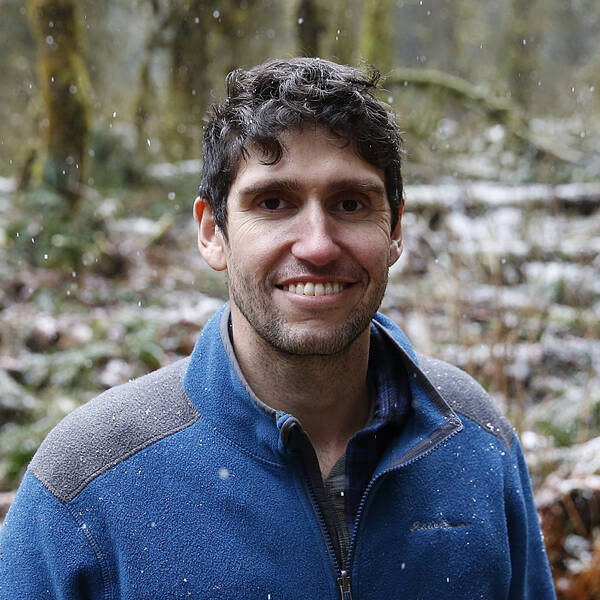Fall 2020
A Speedy Comeback?
Pronghorn have made their triumphant return to Death Valley. Now the question is: How far will they go?
Twenty thousand years ago, a visitor to the American West would have encountered a ferocious menagerie. Lions harassed mastodons, saber-toothed cats pounced on horses, and short-faced bears defended carcasses from marauding dire wolves. Through this assemblage of predators scampered a svelte herbivore, reminiscent of a deer but most closely related to the giraffe: the pronghorn. To spot its fearsome enemies on the open plains, Antilocapra americana evolved enormous eyes and a 300-degree field of vision; to outrun American cheetahs, it gained cushioned toes and oversized lungs. Today, a sprinting pronghorn can reach 55 miles per hour — faster than any other land critter in North America.
When most of the continent’s megafauna went extinct at the end of the Pleistocene, the pronghorn endured. In California, Native tribes such as the Kawaiisu hunted the species, and white colonists, who dubbed it the antelope, marveled at the “great droves, thousands in number” that dotted the Mojave Desert. But the large herds would not last. Market hunters shot them for meat; livestock outcompeted them for forage; fences thwarted their migrations. The final pronghorn in the Mojave was gunned down around 1950, leaving behind only a ghostly place name: Antelope Valley, the arid lowland north of Los Angeles.
Imagine, then, biologists’ delight when a half-dozen pronghorn wandered into a busy area of Death Valley National Park, the Mojave’s most iconic patch of public land, and set up shop this spring. “They’re an expression of the way the landscape used to be, an animal we were still missing,” said Chris Clarke, NPCA’s California desert associate director. The pronghorn’s appearance in Death Valley is also the outcome of decades of conservation work — and, with luck, the plucky band of pioneers will be the vanguard of a broader recolonization.
As many as 1 million pronghorn roam western North America today, with the majority in Wyoming and Montana. That’s a small fraction of the 35 million or so that greeted colonists in the 19th century, but a spectacular increase from the early 1900s, when the population hit its nadir of perhaps 13,000. While pronghorn numbers are overall stable, the Sonoran pronghorn, a smaller subspecies known as the “desert ghost,” has been extirpated from much of its range along the U.S.-Mexico border and may see its habitat further fragmented by the Trump administration’s border wall. The U.S. Fish and Wildlife Service has proposed reintroducing Sonoran pronghorn to an expanse of California desert called Chuckwalla Bench, but there’s no timeline for the project.
In Death Valley, the first pronghorn sighting in recent history actually dates back to 2017, when Bill Sloan, a National Park Service wildlife biologist, received a grainy photo of a pronghorn in the park from a colleague. “I really was speechless — it was so totally unexpected,” Sloan recalled. More pictures rolled in over the following years, from visitors and staff alike. Those early sightings occurred in the park’s higher, northern corners and consisted primarily of “bachelor groups,” loose bands of young males. The small herd that turned up in April, by contrast, included females, and they were loitering just 3 miles from the Furnace Creek Visitor Center.
At first blush, Death Valley might seem an unlikely home for an ungulate most commonly found roaming Wyoming’s cold, lofty plains. Death Valley is forbidding habitat for most creatures: The hottest temperature ever recorded on Earth — 134 degrees — was registered there in 1913, and less than 2 inches of rain falls in the park each year.
For a few weeks each spring, though, Death Valley teems with life. When the rains come early and gentle, the park’s deserts turn into vibrant carpets of desert dandelion, Mojave aster, desert pincushion and other wildflowers that draw bloom-peepers from around the world. For pronghorn, all that new growth means fine dining. According to Laura Cunningham, California director of the Western Watersheds Project, pronghorn may have followed the tasty flowers down from Nevada. A 30-mile trek across state lines would be downright leisurely for pronghorn, which in Wyoming migrate up to 150 miles for prime forage.
“They shift their range to take advantage of resources on the ground,” Cunningham said.
Sloan, though, pointed out that Death Valley experienced “superbloom” years well before 2017 without luring pronghorn. He thinks that as herds have grown just across the Nevada border, animals may be dispersing farther in search of new territory. “This has been a long time in the making,” Sloan said.
In a way, the seeds for the pronghorn’s recovery were planted by Minerva Hamilton Hoyt, the legendary socialite and gardener who, in the 1930s, first advocated for a network of protected areas in the Mojave. Hoyt’s big-picture vision was at last fulfilled in 1994, when the California Desert Protection Act expanded Death Valley and Joshua Tree National Monuments (and redesignated them as national parks) and created Mojave National Preserve. In the years since, NPCA and other conservation groups have fought to stave off threats that would fragment the Mojave — a landfill along a migratory corridor, a cluster of fancy homes near Joshua Tree, suburban sprawl pretty much everywhere. Hoyt “had the big landscape picture in mind, and we’re trying to fill in the puzzle pieces,” Clarke said.
The Mojave’s jigsaw became even more complete in 2016, when President Barack Obama designated three new national monuments in California: Mojave Trails, Castle Mountains and Sand to Snow. The monuments encompass 1.8 million acres, and, crucially, plugged the gaps between existing parks — creating the precise sort of contiguous landscape that wide-ranging pronghorn need to flourish.
“We built the ballpark, and the pronghorn are coming,” Clarke said.

National Parks
You can read this and other stories about history, nature, culture, art, conservation, travel, science and more in National Parks magazine. Your tax-deductible membership donation of $25 or more entitles…
See more ›Just how far will they go? Fewer than 250 miles separate Death Valley and Joshua Tree — not an insurmountable distance for an animal that’s been spotted 40 miles from the nearest water source, according to Sloan. But the coast is by no means clear. Massive energy projects such as Soda Mountain Solar, a proposed 2,000-acre development on Mojave National Preserve’s border, would place new infrastructure in wildlife’s path. The proposed Cadiz pipeline, which would funnel water from desert springs to subdivisions, could drain precious oases. Major highways cleave the desert, creating rivers of traffic that may stymie pronghorn unless the roads are retrofitted with animal-friendly underpasses or bridges.
An animal that survived the Pleistocene, though, can never be counted out — and in Death Valley, the species has already proved its resilience. Although the herd likely decamped from the park when food and water dried up in summer, they accomplished some crucial business before departing. On May 13, Sloan received the most thrilling photos yet: Pictures of two gangly, knob-kneed fawns in Death Valley’s rugged northern mountains.
It seemed to Sloan only fitting that a creature that embodies superlatives has returned to such an extreme environment. “It’s incredible that we can have the fastest, most keen-eyed mammal,” he said, “in the lowest, hottest, driest, place in North America.”
About the author
-
 Ben Goldfarb Author
Ben Goldfarb AuthorBen Goldfarb is the author of "Crossings: How Road Ecology is Shaping the Future of Our Planet" and “Eager: The Surprising, Secret Life of Beavers and Why They Matter.”


